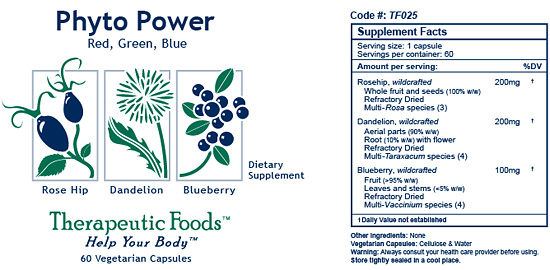Berries Protect the Brain
Dear Friends
According to food researchers Elizabeth Devore ScD, Jae Hee Kang ScD, Monique Breteler MD/PhD, and Francine Grodstein ScD greater intakes of blueberries and strawberries were associated with slower rates of cognitive decline. Additionally, in further supporting evidence, greater intakes of anthocyanidins and total flavonoids were associated with slower rates of cognitive decline. Good news for all of us “baby boomers” if we choose to take this ever growing body of knowledge seriously into our dietary habits. Their summary statement couldn’t be clearer: Higher intake of flavonoids, particularly from berries, appears to reduce rates of cognitive decline in order adults.
To face this cognitive dilemma of old age, or any added stress on the brain bring into your diet the anthocyanidin and flavonoid power provided in two Therapeutic Foods: Phyto Power and Wild Blueberry Extract.

The blue (anthocyanins) in Phyto Power comes from four wild-crafted Alaskan Vaccinium species- Blueberry, huckleberry, lingonberry and Bilberry. Their anthocyannin percent is unmatched for a whole food: 4-6% standardized.
The red comes from a blend of rosehips from wild Arctic Rosa species. Hand picked in Alaska’s pristine wilderness. The flavonoids of interest include luteolin, quercitin, hyperoside, phloridzin and organic acids that include ellagic, chlorogenic and photocatechuic. These phytonutrients occur at ten times the levels compared to the nutritional and medicinal gold standard for European rosehip. It also possesses 1.7% lycopene and related carotenoids, vitamin C average 300% DRI and niacin is 73% RDI.
The green is a propriety whole herb blend of four Taraxacum species (meadow dandelion). The whole plant and roots contain a long list of bioactive flavonoids. Phyto Power supplies the roots, leaves and flowers.
In our Wild Blueberry Extract supplement, we have concentrated the phenolics. A typical C of A results show 65% total phenolic, 19% anthocyanins and 5.8% chlorogenic acid with an ORAC of 7000 umole/gram. It takes us one cup and one-quarter of the Nova Scotia wild blueberries to fill one 500 mg capsule. The color is so blue that it is almost black. It provides much antioxidant, anti-inflammatory, neuro-regenerative punch as documented over the years by our doctors with their patients. I hear quite frequently from our clints that they have tried the product on their animals with amazing results. After all it was, in part, the therapeutic success in animal research that made the case for possible successful outcomes for us humans.
Sincerely yours,
Seann Bardell
Clinical Notes:
Wild Blueberry Extract: For optimal brain health (foggy brain, memory issues, dementia, cognitive dysfunction) take the therapeutic dosage of one to two capsule daily, then build up as necessary after a week. Remember, it is intensely concentrated food but it will take a little time. Build up the dosage until brain function improves, then readjust dosage downwards for maintainance.
Phyto Power: For optimal brain and nervous system it faciliates the bioavailability of the Wild Blueberry Extract, and can be used on its own. Start with two capsules for thereapeutic dosages and build up. As with the Wild Blueberry Extract, after brain function improves, readjust the dosage downward until you arrive to the maintainance stage.
Example: For Dohrea’s PhD studies, we have created a routine of two Wild Blueberry Extract capsules plus three Phyto Power capsules. Taken every morning when she has to write papers (which is now all the time). At break time, between terms, we lower the amount to one a day of each product.
The Last Quiz Answer:

The gastric brooding frog (Rheobatrachus vitellinus) is the only amphibian known to raise their young in their stomachs. They were discovered in the undisturbed rainforests in Austrialia. The female swallows her fertilized eggs, which then hatch in her stomach. When they become fully developed tadpoles the mother vomits them out into the pond where they will develop into adult frogs. How is the mother’s stomach acid and pepsin kept from digesting the tadpoles? Good question but these studies which might have led to important new insights for treating human peptic ulcers could not be continued because this species is now extinct. This information was gathered from a phenomenal book by Chivian and Bernstein, Harvard Professors and MDs, entitled Sustaining life: How Human Health Depends on Biodiversity, published in 2008.

